Speech Therapist School


Understanding the Role and Education of a Speech Therapist
Speech therapists, also known as speech-language pathologists (SLPs), are vital professionals who diagnose and treat communication and swallowing disorders across diverse populations. Pursuing this career involves rigorous education and clinical training, followed by licensure and certification. This article explores the educational pathways, licensure requirements, career prospects, and the demanding yet fulfilling journey of becoming a speech therapist, with a focus on the prominent standards set by California and accredited programs nationwide.
Foundations of Speech Therapy Education
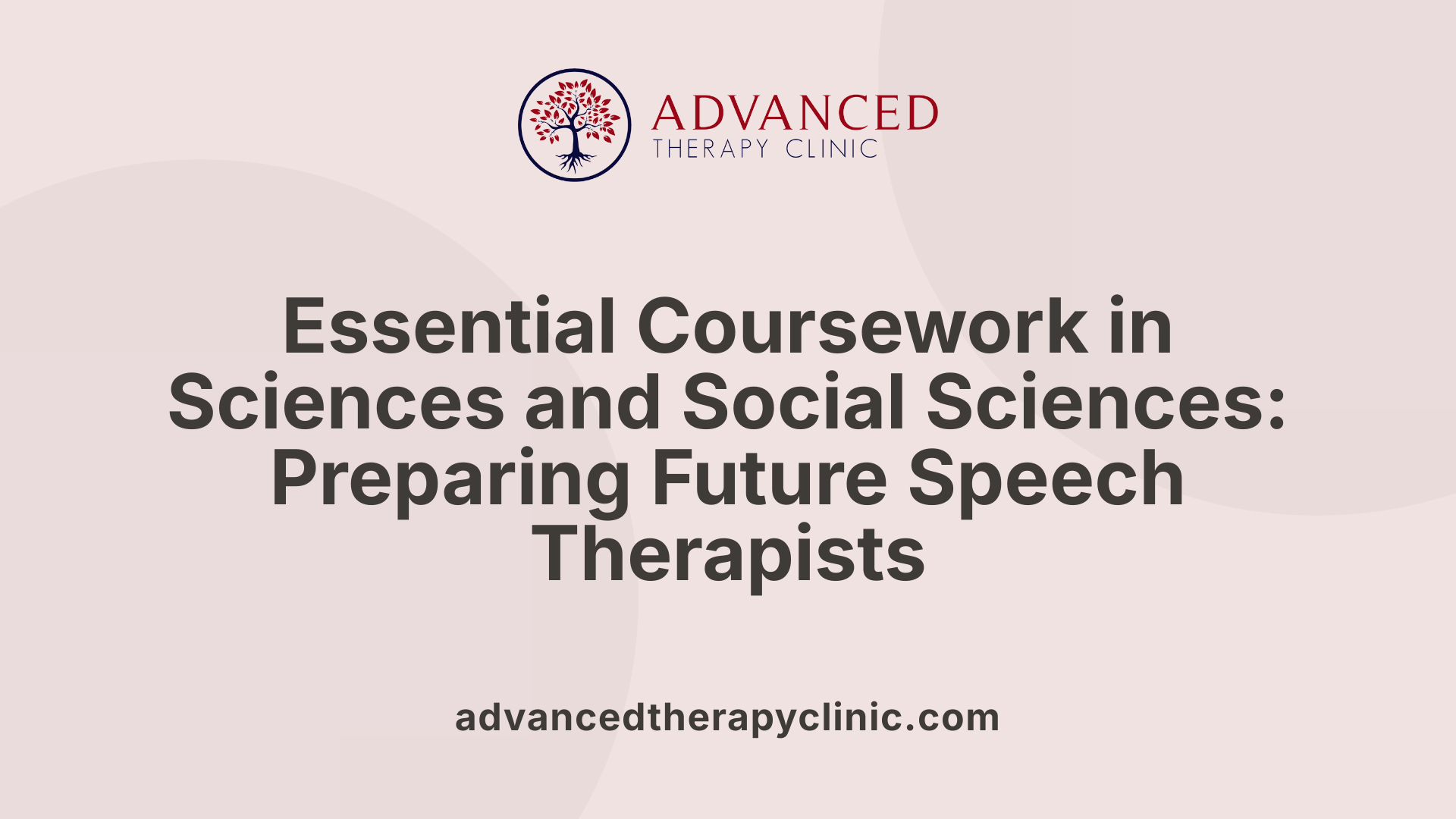
What are the educational prerequisites for speech therapy?
To begin a career in speech therapy, aspiring speech-language pathologists (SLPs) typically start with a strong educational foundation. The first step is obtaining a bachelor's degree, usually in communication sciences and disorders or a related field. This degree lays the groundwork for advanced study by providing essential insights into human communication and its disorders.
What are the bachelor's degree requirements?
Most programs require students to maintain a minimum GPA of around 3.0 and complete prerequisite coursework. These courses often include a blend of sciences and social sciences, which are critical for understanding the complexity of speech and language development as well as related disorders. Additionally, some programs expect applicants to have completed clinical observation hours to gain practical exposure.
Why is communication sciences and disorders important?
A bachelor's degree in communication sciences and disorders is important because it offers aspiring SLPs an overview of language development, speech disorders, hearing impairments, and typical communication processes. This specialized degree equips students with foundational knowledge and skills, enhancing their readiness for rigorous graduate-level education and clinical practice.
What is the role of coursework in sciences and social sciences?
Coursework in areas such as psychology, linguistics, human anatomy, and physiology plays a vital role in speech therapy education. These subjects help students understand the biological, cognitive, and social facets of human communication. For instance, anatomy and physiology provide knowledge about the speech mechanisms, while psychology and linguistics explain language acquisition and cognitive processing.
These combined educational components ensure that students are well-prepared to advance into graduate programs, which further specialize in speech-language pathology with clinical training and comprehensive theoretical study.
Master's Degree: The Core of Speech Therapist Training
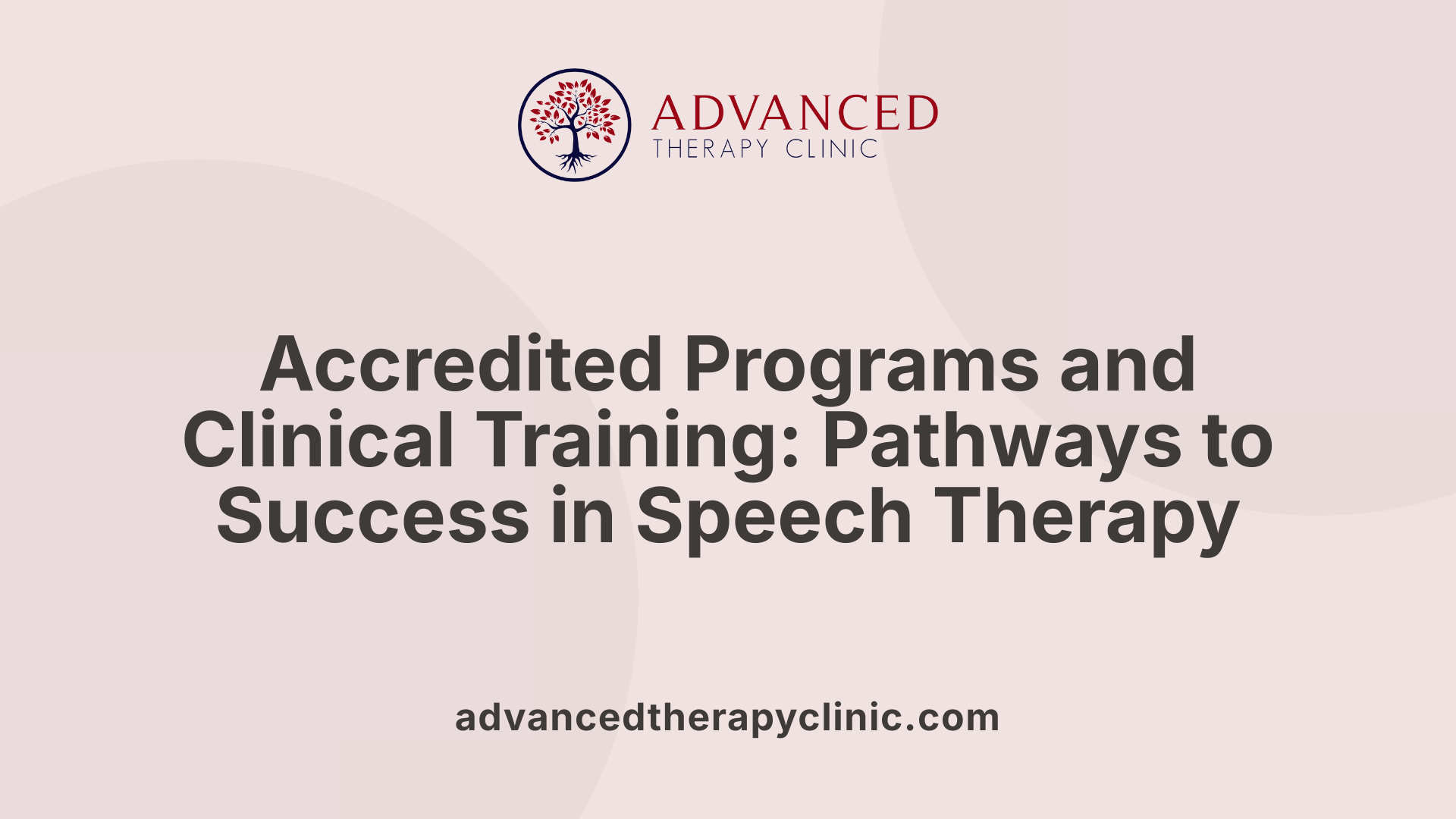
Why is a Master's Degree Essential for Becoming a Speech Therapist?
A master's degree in speech-language pathology is an essential credential for anyone aspiring to become a licensed speech-language pathologist (SLP) in California. This graduate degree provides the rigorous training and clinical experience necessary to diagnose and treat communication and swallowing disorders effectively. Without completion of a master's program, candidates cannot proceed toward certification or licensure.
How Important is ASHA Accreditation?
Programs accredited by the American Speech-Language-Hearing Association (ASHA) ensure high standards in coursework, clinical training, and overall educational quality. In California, it is mandatory to graduate from an ASHA-accredited master's program to meet state licensure requirements. Currently, California hosts more than 20 such accredited programs recognized by the California Speech-Language Pathology and Audiology Board.
What Does the Typical Curriculum Include?
Master’s programs focus on a multidisciplinary curriculum encompassing linguistics, psychology, physiology, and related sciences. Students undertake core courses that include:
- Speech-Language Screening
- Dysphagia (swallowing disorders)
- Voice Disorders
- Augmentative and Alternative Communication
These courses lay a scientific foundation while preparing students for diverse clinical challenges.
What are California’s Specific Coursework and Clinical Hour Requirements?
California mandates at least 60 semester units of graduate coursework paired with approximately 400 supervised clinical hours prior to graduation. These clinical experiences span multiple settings, enabling hands-on practice under professional supervision.
How Long Does the Program Usually Take?
Most master’s programs are designed as two-year full-time commitments. However, alternatives such as part-time and online options are increasingly available to accommodate different student needs and schedules. Regardless of format, the focus remains on comprehensive academic and clinical preparation to meet licensure prerequisites.
This combination of advanced coursework, ASHA accreditation, and extensive clinical experience positions graduates for success in California's competitive and in-demand speech therapy field.
Clinical Experience During Graduate Studies
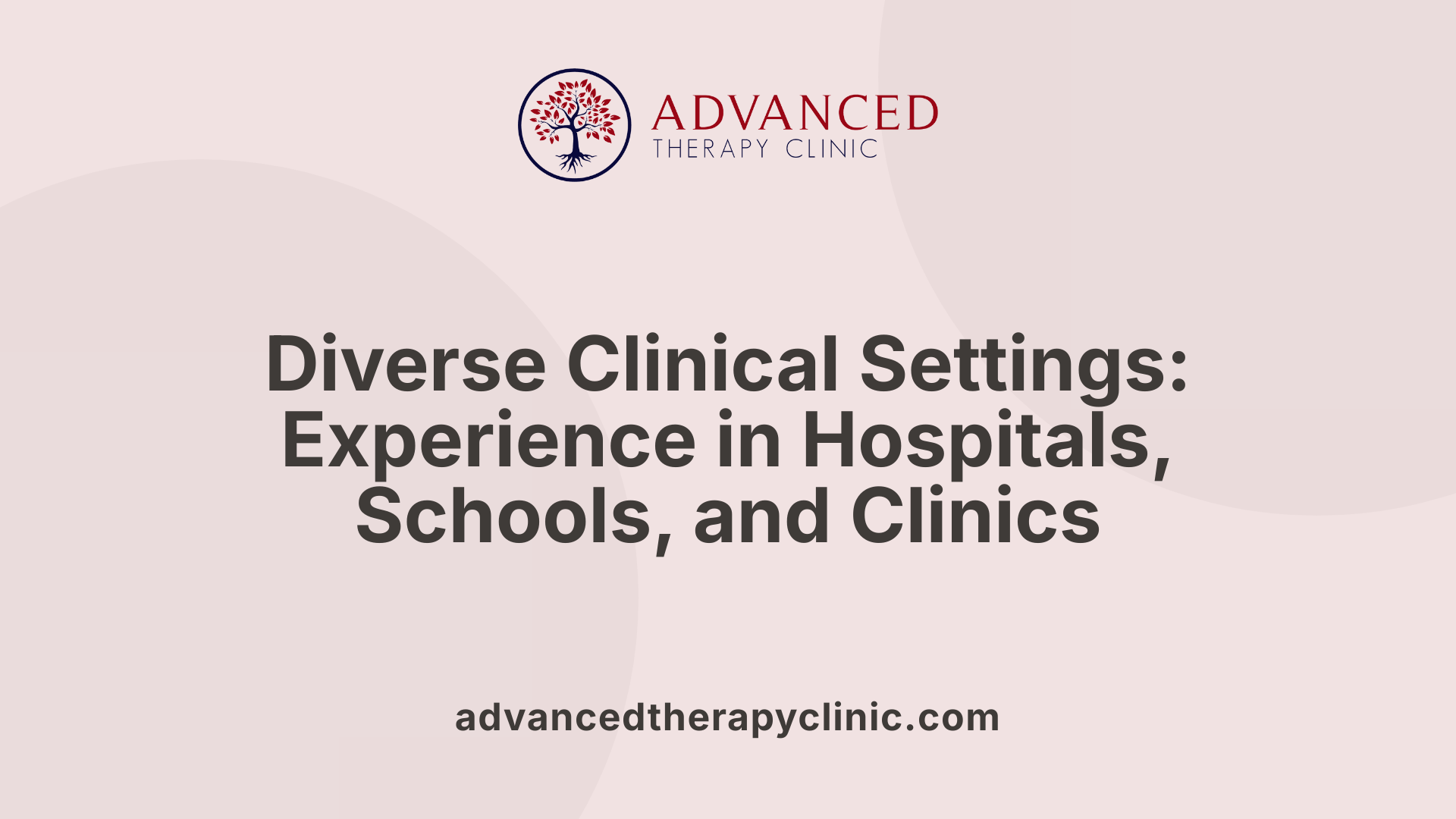
What supervised clinical hours are required in master's programs?
Master’s programs in speech-language pathology in California require students to complete approximately 400 supervised clinical hours. This includes at least 25 hours of guided observation and about 375 hours of direct patient contact. These hours are essential for developing practical skills in diagnosing and treating communication and swallowing disorders.
What variety of clinical settings do students experience?
Students gain experience in diverse environments such as hospitals, schools, clinics, and rehabilitation centers. Exposure to a wide range of patient populations and communication challenges helps prepare them for the versatility required in professional practice.
How do these clinical hours enhance hands-on skills and knowledge?
Engaging in supervised clinical practice allows students to apply theoretical knowledge to real-world cases under the guidance of licensed speech-language pathologists. This immersion builds their confidence, sharpens diagnostic abilities, and hones therapeutic techniques necessary for effective patient care.
By completing these supervised practicum hours, graduate students meet the accreditation standards essential for eligibility towards licensure and certification as speech-language pathologists in California.
Clinical Fellowship Year: Transitioning to Professional Practice
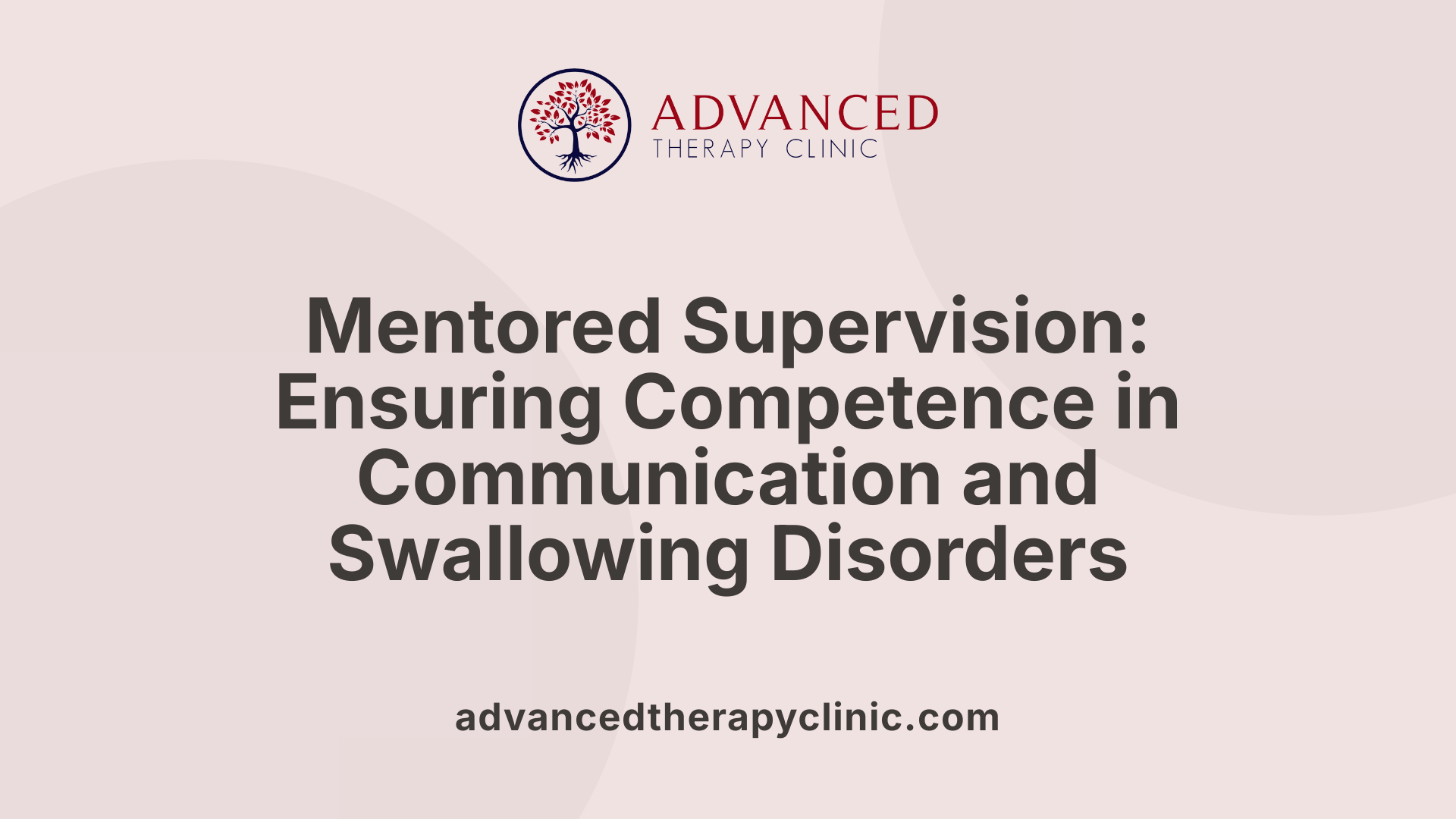
What is the Clinical Fellowship Year (CFY)?
The Clinical Fellowship Year (CFY) is a critical 36-week supervised clinical fellowship that newly graduated speech-language pathologists (SLPs) in California must complete. This transitional period provides hands-on professional experience under the guidance of a licensed SLP supervisor.
Why is supervision by a licensed SLP essential?
Throughout the CFY, licensed SLP supervisors mentor fellows by providing clinical oversight, professional feedback, and support. This relationship ensures that fellows develop strong clinical skills and adhere to best practices in diagnosing and treating communication and swallowing disorders.
How does the CFY fulfill licensure and certification requirements?
Successfully completing the CFY—which equals approximately 1,260 hours of supervised clinical practice—is mandatory for state licensure in California. It also fulfills requirements set by the American Speech-Language-Hearing Association (ASHA) for obtaining the Certificate of Clinical Competence in Speech-Language Pathology (CCC-SLP).
How does the CFY bridge academic learning and independent practice?
While completing their master’s degree, students engage in coursework and approximately 400 clinical hours. The CFY builds upon this foundation, allowing new SLPs to apply theoretical knowledge in real-world settings while gradually assuming greater clinical responsibilities until they are prepared for independent practice.
This clinical fellowship marks the essential transition between academic preparation and full professional competence as a licensed speech-language pathologist.
Licensure and Certification Requirements
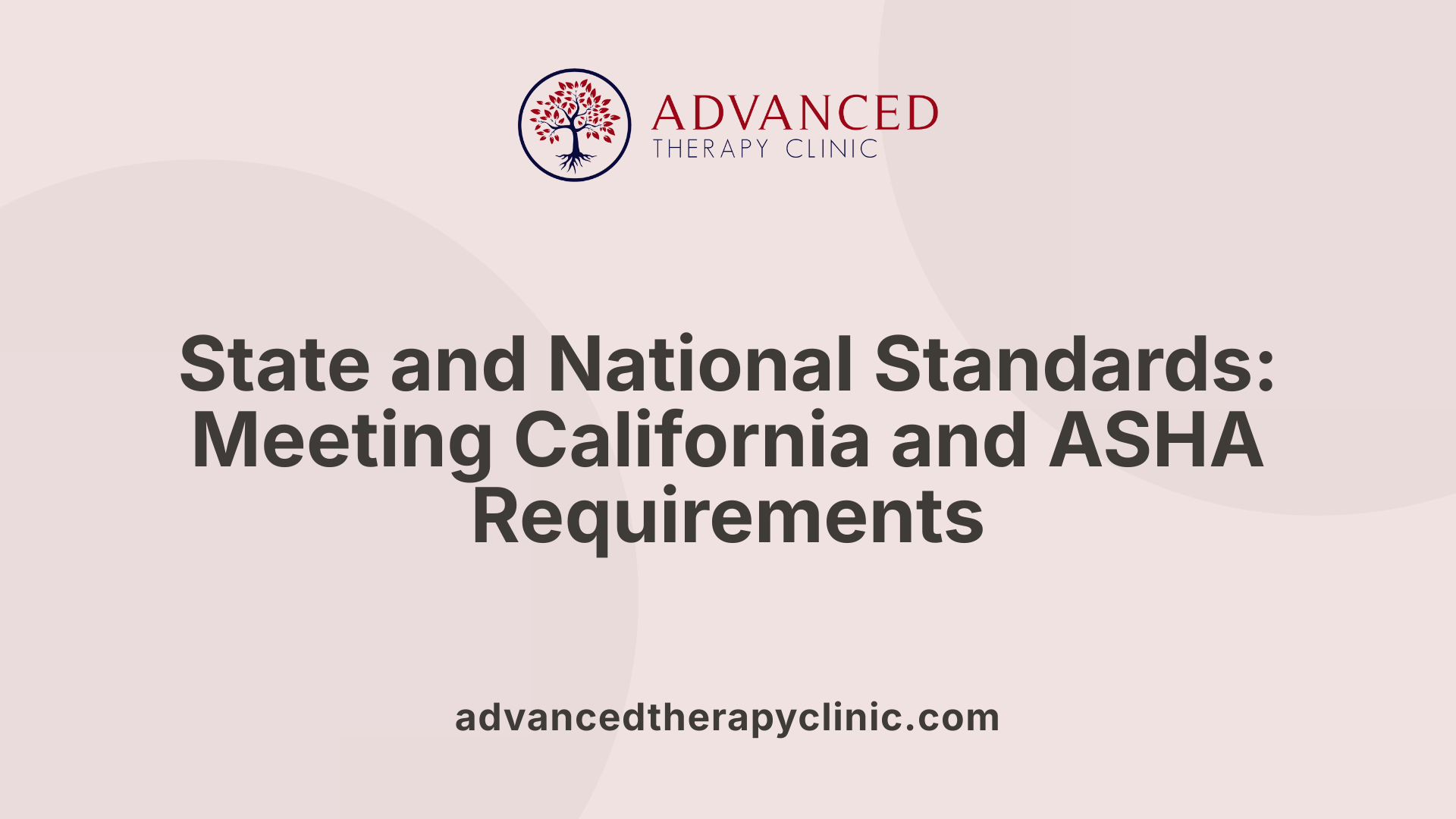
What are the Praxis Speech-Language Pathology Examination requirements and passing score?
To become a licensed speech-language pathologist (SLP) in California, candidates must pass the Praxis Speech-Language Pathology Examination with a minimum score of 162. This national exam assesses knowledge and skills essential for effective clinical practice.
What does the application process in California involve?
Applicants need to complete a thorough application process with the California Speech-Language Pathology and Audiology Board. This includes payment of application fees, submission of fingerprinting for a background check, and verification of required supervised clinical hours.
How are clinical hours verified?
Verification requires documentation of at least 400 clinical hours completed during the accredited master’s program, plus 36 weeks of supervised clinical fellowship post-graduation. These hours must be confirmed by licensed SLP supervisors to ensure adherence to state and ASHA guidelines.
What is the role of ASHA certification and the CCC-SLP?
Beyond state licensure, many SLPs seek the Certificate of Clinical Competence in Speech-Language Pathology (CCC-SLP) awarded by the American Speech-Language-Hearing Association (ASHA). To earn the CCC-SLP, candidates must submit graduate transcripts, Praxis exam results, and clinical fellowship reports to ASHA. This credential is nationally recognized and enhances professional credibility and employment opportunities.
Are there California-specific licensing nuances?
Yes, California mandates fingerprinting as part of its licensing process and requires continuing education every two years to maintain licensure. Additionally, for SLPs working within educational systems, extra certification like the California Speech-Language Pathology Services Credential is necessary. These state-specific requirements ensure high standards of professional practice tailored to California’s diverse population and regulatory environment.
Career Settings and Professional Opportunities

Diverse Work Environments for Speech-Language Pathologists
Speech-language pathologists (SLPs) in California enjoy a variety of work settings, reflecting the broad demand for their expertise. Common environments include public and private schools, hospitals, healthcare clinics, and private practices. Each setting offers unique challenges and patient demographics, from pediatric cases in schools to adult rehabilitation in hospitals.
Credentials and Requirements in Educational Settings
Working within public or private educational systems typically requires additional credentials beyond state licensure, such as the California Speech-Language Pathology Services Credential. This ensures that SLPs are equipped to address the specific needs of students with communication disorders, supporting both academic and social development.
Career Advancement and Professional Growth
SLPs have multiple avenues for career advancement. Beyond clinical practice, opportunities exist in research, academia, healthcare administration, and supervision of speech-language pathology assistants (SLPAs). Advanced certifications like the ASHA Certificate of Clinical Competence (CCC-SLP) and further graduate studies can propel professionals into leadership, policy-making, or specialized therapy roles.
Emphasis on Bilingual and Multicultural Training
Given California’s diverse population, bilingual and multicultural training is crucial. Master’s programs often incorporate this focus to prepare SLPs for culturally competent care, enabling effective communication with clients from varied linguistic and cultural backgrounds and improving therapy outcomes.
Alternative Careers Leveraging Communication Expertise
Apart from traditional roles, individuals with speech-language pathology training can pursue alternative paths such as vocal coaching, clinical writing, marketing in health-related fields, and interpreting services. These career options utilize core skills in communication enhancement and therapeutic practices, broadening professional opportunities.
| Setting/Pathway | Description | Notes |
|---|---|---|
| Schools | Support students with speech/language needs; require special credentials | Includes role in early intervention programs |
| Hospitals/Clinics | Treat a wide range of disorders; adult and pediatric populations | Opportunity for specialized clinical practice |
| Private Practice | Independent or group practices; flexible work environments | Often requires business acumen |
| Research/Academia | Conduct studies or teach future SLPs | Requires advanced degrees |
| Healthcare Administration | Oversee clinical operations and policy | Involves leadership and organizational skills |
| Alternative Careers | Vocal coaching, clinical writing, marketing, interpreting | Leverages communication and therapy expertise |
Job Market Outlook and Salary Expectations
What are the employment growth projections for speech-language pathologists in California and nationwide?
The job market for speech-language pathologists (SLPs) is highly promising both in California and across the United States. In California, employment projections show a strong growth rate ranging from 23.5% to nearly 29% between 2020 and 2030. Nationally, the growth outlook is also robust, with forecasts between 19% and 21% from 2021 to 2032. This rapid expansion indicates a substantial increase in demand for speech therapists.
What factors are driving this growth?
Several key factors are propelling the increased demand for SLPs:
- Aging populations: As older adults are more prone to communication and swallowing disorders, the need for specialized care rises.
- Early intervention programs: Expanded services for children with speech and language impairments enhance long-term outcomes.
- Public schools: Growth in special education services fuels demand for speech therapy in educational settings.
These elements combined ensure that speech therapy remains an essential and growing profession.
How do salaries for speech-language pathologists in California compare nationally?
California stands out with the highest median salary for SLPs in the nation. Salaries range approximately from $106,410 to $112,030 annually in California, reflecting the state's cost of living and strong demand. By comparison, the national median salary for SLPs hovers around $89,290 per year. This significant difference makes California an attractive state for professionals seeking competitive compensation.
What employment settings offer positive job prospects?
Speech-language pathologists enjoy diverse career opportunities, including:
- Schools and educational institutions
- Hospitals and healthcare facilities
- Private practices
- Residential care centers
Across these multiple settings, the demand for qualified SLPs remains high, supported by continuing awareness of communication disorders and the importance of therapeutic intervention.
Overall, speech-language pathology offers strong career growth and competitive salaries, especially in California, driven by demographic trends and expanding services in healthcare and education.
Continuing Education and Professional Development
What is required for continuing education to maintain licensure in California?
Speech-language pathologists (SLPs) licensed in California must complete at least 24 hours of continuing education every two years to renew their license. This requirement ensures that practitioners stay current with advances in the field and maintain high standards of care throughout their careers.
Why is ongoing training important for speech-language pathologists?
Continuing education is vital for SLPs to keep up with evolving techniques, technologies, and research. It supports professional growth and helps practitioners refine their skills in areas such as bilingual therapy, telepractice, and specialized disorders.
What advanced certifications can enhance an SLP's career?
Several advanced certifications are available to enhance an SLP's expertise and marketability. These include:
- Board Certified Behavior Analyst (BCBA): Focuses on applied behavior analysis, often used in autism therapy.
- Picture Exchange Communication System (PECS): Specialized training in augmentative communication.
- Lee Silverman Voice Treatment (LSVT LOUD): Certification for voice therapy, particularly for Parkinson’s disease.
Are there opportunities for higher education beyond a master’s degree?
Yes, SLPs can pursue higher education such as doctoral degrees for advanced clinical research, leadership, and academic roles. Dual degree programs also exist, providing interdisciplinary skills that broaden career opportunities in healthcare administration, education, and policy.
These continuing education and professional development pathways not only maintain licensure but also empower speech-language pathologists to expand their expertise and impact in diverse clinical and educational settings.
Online and Alternative Pathways in Speech Therapy Education
Availability of Online and Part-Time Master's Degree Programs
California offers various master's degree programs in speech-language pathology that accommodate different learning styles and schedules. Most programs are traditional two-year full-time tracks, but many universities provide part-time and online options to increase accessibility for working professionals and students with other commitments. These programs maintain rigorous standards while offering flexibility in coursework delivery.
Online Speech-Language Pathology Assistant (SLPA) Programs
In addition to master's programs, there are accredited online Speech-Language Pathology Assistant programs, such as those offered by the University of Alaska Anchorage and Laramie County Community College. These programs typically lead to associate degrees, bachelor’s degrees, or certificates and include online instruction combined with supervised clinical fieldwork essential for certification and licensure.
Program Flexibility Paired with Clinical Practicum Requirements
Regardless of being online or in-person, speech therapy education requires substantial clinical practice. Master's programs often mandate about 400 supervised clinical hours before graduation, including practicum placements in diverse settings like hospitals, schools, or private clinics. Similarly, online SLPA programs include flexible online coursework paired with required clinical fieldwork supervised by licensed professionals to ensure practical competency.
ASHA Accreditation for Online Programs
To ensure high educational quality and eligibility for certification and licensure, online and alternative speech therapy programs must be accredited by the American Speech-Language-Hearing Association (ASHA) and recognized by relevant state boards such as California’s Speech-Language Pathology and Audiology Board. This accreditation confirms adherence to professional standards including adequate clinical experience.
Pathway from SLPA to Advanced Degrees and Licensure
Graduates of SLPA programs have a clear pathway to pursue advanced degrees in speech-language pathology. Completing an accredited master's program remains mandatory for full licensure and certification as an SLP. The combination of flexible learning options and clinical practicum requirements supports lifelong learning and career advancement in the field of speech therapy.
Admission Standards and Candidate Preparation
Typical Admission Requirements
Most Master's programs in speech-language pathology (SLP) favor applicants with a bachelor's degree in communication sciences, speech-language pathology, or related fields. This foundational education ensures candidates possess relevant knowledge before advancing.
Minimum GPA Expectations
Institutions generally require a minimum GPA around 3.0 on a 4.0 scale. This standard reflects academic rigor and readiness for graduate coursework.
Clinical Observation Hours
Before admission, many programs expect candidates to complete clinical observation hours. These experiences offer practical insight into speech therapy practices and patient interactions, enhancing applicant preparedness.
GRE Requirements
Graduate Record Examination (GRE) requirements vary; some graduate SLP programs mandate it, while others do not. Prospective students should check specific program criteria.
Emphasis on Bilingual and Multicultural Skills
Given California’s diverse population, programs emphasize bilingualism and multicultural competence during admissions, preparing future clinicians to serve varied communities effectively.
Role of Speech Therapists: Conditions Treated and Therapies Provided
What Conditions Do Speech Therapists Treat?
Speech therapists, also known as speech-language pathologists (SLPs), work with patients experiencing a wide range of communication and swallowing disorders.
Common conditions include developmental delays, autism spectrum disorders, stroke-related impairments, cleft palate, hearing loss, and neurological diseases such as Parkinson’s disease. These conditions can cause difficulties in speech clarity, language understanding and expression, voice quality, fluency, and swallowing function.
How Do Speech Therapists Approach Treatment?
The therapy process involves developing personalized plans tailored to each individual's needs. SLPs assess the patient's specific challenges and design interventions to improve communication skills and swallowing ability.
Therapies may focus on enhancing speech production, language comprehension, voice modulation, fluency techniques, or safe swallowing strategies. Targeted exercises, behavioral modifications, and assistive communication devices are often incorporated.
How is Telepractice Changing Service Delivery?
Telepractice is an innovative approach enabling SLPs to provide therapy remotely using video conferencing and digital tools. This expands access to speech services, especially for clients in rural or underserved areas.
Telepractice maintains effectiveness by allowing real-time interaction and guided exercises, supporting continuous care without physical visits.
Through a combination of direct clinical intervention and modern technology, speech therapists play a crucial role in improving quality of life for individuals facing speech and swallowing challenges.
Multicultural Competence and Community Impact
Why is bilingual and multicultural training crucial in speech therapy education?
Speech-language pathology programs in California emphasize bilingual and multicultural training to equip future clinicians with the skills necessary to serve a linguistically and culturally diverse population. This training enables therapists to effectively assess and treat clients from various backgrounds, ensuring culturally sensitive and accurate communication interventions.
How does California’s diverse population shape program curricula?
California’s unique cultural and linguistic diversity drives educational programs to integrate multicultural competencies into their curricula. Courses often include instruction on different languages, cultural communication styles, and culturally relevant disorders, preparing students to address the specific needs of communities such as Hispanic, Asian, and other non-English-speaking groups.
What partnerships support inclusive clinical placements?
Speech-language pathology programs partner with local health care facilities, schools, and community organizations to provide clinical placements that reflect the state’s diversity. These collaborations allow students to gain practical experience with a broad spectrum of clients, ensuring exposure to varied dialects, age groups, and cultural contexts.
How does this emphasis impact community access and outcomes?
The focus on multicultural competence improves access to quality speech therapy services for underserved and minority populations. Therapists trained in cultural sensitivity and bilingualism contribute to better diagnostic accuracy, personalized interventions, and ultimately, improved communication outcomes for diverse communities throughout California.
The Future of Speech Therapy Education and Careers

How is Telepractice Transforming Speech Therapy?
Telepractice is rapidly expanding access to speech therapy services by enabling remote delivery. This transformation allows speech-language pathologists (SLPs) to reach clients in rural or underserved areas, overcoming traditional geographic barriers. Remote therapy also offers convenience and flexibility for clients and clinicians alike, helping to maintain continuity of care even amid disruptions.
What New Certifications and Interdisciplinary Skills Are Emerging?
New certifications such as PECS (Picture Exchange Communication System), BCBA (Board Certified Behavior Analyst), and LSVT LOUD (Lee Silverman Voice Treatment) are enhancing professional expertise. Speech therapists increasingly combine interdisciplinary knowledge from fields like psychology, linguistics, and healthcare administration. Dual degree programs and advanced certifications equip SLPs with leadership abilities and specialization options.
What Leadership and Research Opportunities Are Available?
As the profession evolves, speech therapists have growing opportunities to take on leadership roles—such as therapy managers or department directors—and engage in research to advance therapeutic methods. Doctoral-level education opens doors to academia, policy advocacy, and clinical innovation, contributing to improved patient outcomes.
How Are Therapy Standards and Technology Evolving?
Standards for education and clinical practice continue to align with technological advancements such as telepractice tools, digital assessment methods, and data-driven therapy plans. Accredited programs emphasize competencies in both traditional and emerging technologies, preparing graduates for modernized service delivery.
Why Is Demand for Speech Therapy Growing?
Greater recognition of communication disorders, increased early intervention programs, and an aging population drive a strong rise in demand for speech therapy services. This growth fuels employment prospects, encouraging expanded educational offerings and continuous professional development.
Together, these trends shape a vibrant future for speech-language pathology, blending innovative care approaches with expanded career paths.
Charting a Successful Pathway to Professional Speech Therapy Practice
Becoming a speech therapist is a challenging but deeply rewarding journey demanding academic rigor, clinical excellence, and continuous professional growth. From foundational bachelor’s degree preparation to rigorous master's programs, supervised internships, licensure, and ongoing education, aspiring SLPs must navigate a comprehensive pathway that equips them to serve diverse populations effectively. With a positive job outlook, competitive salaries, and numerous career settings, the field offers abundant opportunities for specialization and impact. As communication needs evolve with technology and demographics, future speech therapists will play an essential role in expanding access, innovating therapy delivery, and improving lives through expert care and advocacy.
References
- How to Become a Speech-Language Pathologist in California
- How to Become a Speech Therapist in California
- 25+ California Speech-Language Pathology (SLP) Programs
- How to Become a Speech Therapist (SLP)
- How To Become A Speech Pathologist: 6 Crucial Career ...
- How to Become a Speech Pathologist – Salary & ...
- Guide to Speech Language Pathology Assistant Programs ...
Recent articles

Autism Stimming Behaviors
Understanding the Complex World of Autism Self-Regulation

The Benefits of Occupational Therapy for Enhancing Attention to Task
Enhancing Focus and Engagement in Children Through Occupational Therapy

What Is Virtual Autism
Unveiling the Symptoms, Causes, and Prevention of Virtual Autism

ICD-10 Code For Autism
Understanding the ICD-10 Classification for Autism Spectrum Disorder

Handwashing & Showering To Kids With Autism
Empowering Autism Through Hygiene Learning Strategies

How ABA Therapy Can Improve Classroom Behavior
Transforming Learning Environments with Evidence-Based Interventions


